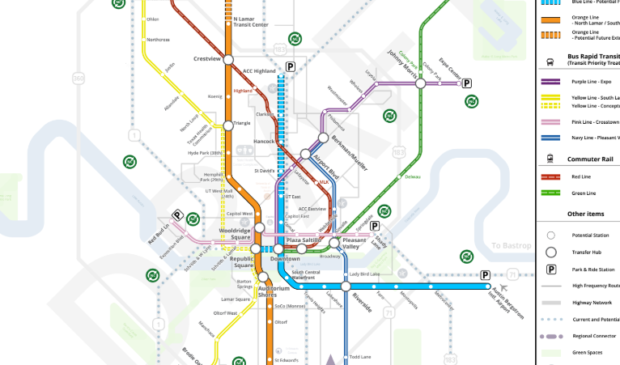New Project Connect plan has ambitions for 2020
Thursday, November 15, 2018 by
Jessi Devenyns Once again, Austin has been reminded of the importance of public transportation, in photos that surfaced this week of the Crystal City metro system that sits right beneath the Amazon headquarters in Crystal City, Va.
“As we plan and plan again, our peer systems are investing,” Scott Morris of the Central Austin Community Development Corporation told the Urban Transportation Commission at its Nov. 13 meeting.
After unveiling the new vision for its Project Connect plan at the Austin Chamber of Commerce’s Future of Regional Mobility Summit in October, Capital Metro has been careful to emphasize that all its plans are far from set in stone, or as Morris pointed out, everything is still in the planning stages.
“Right now it is all conceptual. It’s lines on a map,” said Dave Couch, the Project Connect program officer for Capital Metro, at the meeting. While the project is still in preliminary stages, Couch said that he hopes to have the plan on the 2020 ballot for voters’ approval.
He explained that although a regional high-capacity transit network is the long-term goal for Capital Metro, the agency is hoping to hear and incorporate as much community input as possible in the next 18 months.
The current plan involves upgrading the Red Line commuter rail and adding a second Green Line to Manor, introducing four bus rapid transit “light” lines with signal prioritization, and adding two high-capacity transit lines with dedicated pathways.
Couch suggested that the two dedicated pathway lines should be “automated rapid transit.” ART, however, is a developing technology that has yet to be rolled out as a large-scale solution.
“I think there has been a substantial departure from the system planning that had occurred up until March,” said Morris. He noted it was then that ART entered the discussion.
Commissioner Kelly Davis similarly expressed misgivings about implementing an untested solution into the vision plan.
“Autonomous rapid transit – why? I don’t understand the benefit … in this context.”
Several of the commissioners pointed out that their concern was not so much the types of transit that would be implemented as how they are going to coexist with single-passenger vehicles.
“Dedicated right-of-way being the most important thing to make any of these systems go,” said Commissioner Jonathon Gins, “we should be prioritizing more dedicated right-of-way.”
Since Couch insisted that the current plan is still loosely defined until more public input is received, the commissioners spent over an hour discussing the merits of different transportation options that they could recommend for implementation. In the end, there was no definitive conclusion other than that the overall vision should prioritize rail.
“I’m failing to see what is being discussed beyond … here is this system – sort of,” said Commissioner Mario Champion. “It leaves a lot of room for people to fight because it’s unclear what this is saying.”
Couch told the Austin Monitor that it is difficult to outline a concrete plan because it’s a chicken-and-egg situation: They can’t design without engineering studies, yet they can’t do engineering studies without first having community input for the design.
Although not part of the officially outlined community engagement process, Zenobia Joseph, a community advocate and vocal critic of Capital Metro, came to the meeting to offer her observations that the current plan does not take Title VI of the Civil Rights Act of 1964, which prohibits discrimination, into account. “The only 60-minute bus routes are in the historically black neighborhoods,” she said. She also noted that if you look at the Imagine Austin plan as a whole, “They’ve literally imagined Austin without the people north of the North Lamar Transit Center.”
Commissioner Kelly Davis noted the opposite and expressed interest in Capital Metro expanding its transit lines farther south. “Currently there is no way to get from Kyle to Austin without a car,” she said.
Couch told the Monitor that he appreciates any and all output and welcomed the commentary.
In an effort to push their comments along to City Council, the commission voted to recommend the project and the engineering studies that are required in the next phase. Commissioner Cynthia Weatherby abstained and Commissioner Chris Hosek dissented. Chair D’Ann Johnson was absent from the meeting.
The Capital Metro board will vote on the system plan on Dec. 17, before it goes to Council.
The Austin Monitor’s work is made possible by donations from the community. Though our reporting covers donors from time to time, we are careful to keep business and editorial efforts separate while maintaining transparency. A complete list of donors is available here, and our code of ethics is explained here.
You're a community leader
And we’re honored you look to us for serious, in-depth news. You know a strong community needs local and dedicated watchdog reporting. We’re here for you and that won’t change. Now will you take the powerful next step and support our nonprofit news organization?










